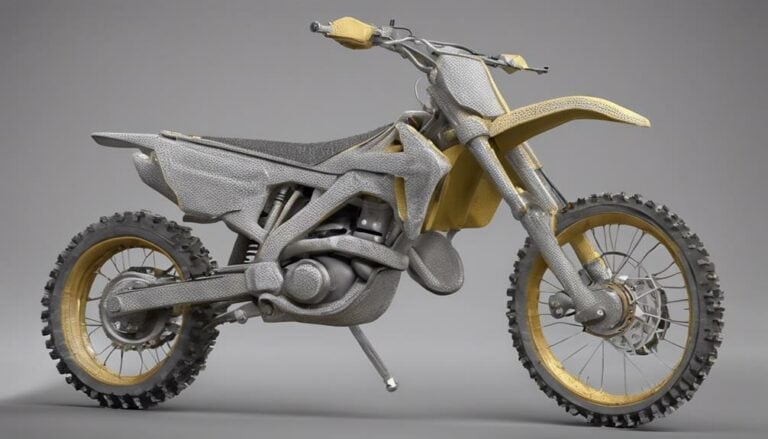Have you ever wondered how the engine types of motocross dirt bikes truly impact their performance on the track?
The choice between two-stroke and four-stroke engines goes beyond just power delivery – it influences everything from acceleration to handling.
So, what exactly sets these engine types apart and how does each one affect the overall performance of a dirt bike?
Let's explore the intricate relationship between engine types and motocross performance to uncover the secrets behind these high-speed machines.
Key Takeaways
- 2-stroke engines offer immediate power for quick acceleration, enhancing agility.
- 4-stroke engines provide smoother power delivery, improving control and traction.
- Engine choice impacts speed, acceleration, and overall performance on the track.
- Weight distribution influences handling, with 2-strokes favoring maneuverability and 4-strokes stability.
Impact of 2-Stroke Engines on Performance
When considering the impact of 2-stroke engines on motocross dirt bike performance, their immediate power delivery stands out as a key factor influencing acceleration and agility on the track.
This rapid power response is achieved through a simpler design with fewer moving parts, resulting in a higher power-to-weight ratio compared to 4-stroke engines.
The combustion cycle of 2-stroke engines, with power strokes on every revolution of the crankshaft, guarantees a quick throttle response that enhances maneuverability in tight corners and quick acceleration out of jumps.
The compression ratio in 2-stroke engines also plays an essential role in generating high power output, allowing riders to tackle challenging terrains with ease.
Additionally, the size of the valves in 2-stroke engines contributes to their efficiency in fuel consumption, making them popular choices for riders seeking competitive motocross performance.
In motocross competitions where speed and agility are paramount, the immediate power delivery of 2-stroke engines provides riders with a competitive edge on the track.
Influence of 4-Stroke Engines on Handling
4-Stroke engines greatly impact the handling of motocross dirt bikes by offering smoother power delivery, enhancing control and traction on the track. The torque characteristics of 4-stroke engines contribute immensely to better handling and stability during cornering. Additionally, the linear power output of these engines aids in managing jumps and obstacles on motocross tracks efficiently. Their more substantial low-end torque allows riders to navigate technical sections with precision. Furthermore, the weight distribution of 4-stroke engines can improve overall balance and handling, essential for ideal motocross performance.
- 4-stroke engines provide smoother power delivery, enhancing control and traction on the track.
- The torque characteristics contribute to better stability during cornering.
- Linear power output aids in managing jumps and obstacles effectively.
- More low-end torque allows for precise navigation in technical sections.
Power Delivery Differences in Engine Types
Examining the power delivery disparities between 2-stroke and 4-stroke engines reveals crucial insights into the performance dynamics of motocross dirt bikes.
2-stroke engines offer immediate power delivery with a power stroke occurring every revolution, resulting in quick acceleration on the track. This characteristic makes them well-suited for riders seeking explosive bursts of power.
In contrast, 4-stroke engines require two revolutions to complete a power cycle, providing a smoother and more controlled power output. This steady power delivery is advantageous for riders looking for consistency in performance, especially when handling tricky terrain.
The operational difference between these engine types directly impacts the speed, acceleration, and efficiency of motocross dirt bikes, influencing factors like torque, fuel consumption, and power-to-weight ratios.
Weight Distribution and Engine Types
Considering the weight distribution implications associated with different engine types in motocross dirt bikes reveals significant impacts on overall performance and handling characteristics. When it comes to weight distribution, 2-stroke engines are typically lighter than 4-stroke engines, leading to enhanced agility and maneuverability on the track. On the other hand, the heavier weight of 4-stroke engines can provide improved stability and traction, positively affecting the bike's overall performance.
The weight distribution of the engine plays a vital role in determining the balance and handling of the dirt bike during motocross riding. Riders often make a choice between 2-stroke and 4-stroke engines based on their preference for weight distribution and how it influences the bike's performance on the track.
- 2-stroke engines: Lighter weight enhances agility and maneuverability.
- 4-stroke engines: Heavier weight offers better stability and traction.
- Weight distribution impacts overall performance and handling.
- Rider preference influences engine choice for desired performance outcomes.
Comparing Acceleration in Different Engine Types
When comparing acceleration performance between different engine types in motocross dirt bikes, the immediate power delivery of 2-stroke engines stands out for its quick and responsive throttle response. 2-stroke engines excel in acceleration due to their favorable power-to-weight ratios and instant power delivery, allowing riders to swiftly navigate the track with bursts of speed.
On the other hand, 4-stroke engines provide a more controlled acceleration experience, offering steady power output and enhanced low-end torque for smoother rides. While 4-stroke engines may not match the instant acceleration of 2-strokes, they compensate with consistent torque delivery, allowing riders to maintain traction and control through various terrains.
The power delivery differences significantly impact the acceleration capabilities of motocross dirt bikes, influencing how riders handle jumps, corners, and straightaways on the track. Ultimately, the choice between 2-stroke and 4-stroke engines in motocross racing depends on individual preferences for acceleration style and track conditions.
Conclusion
To sum up, when it comes to choosing between two-stroke and four-stroke engines for motocross dirt bikes, it's like comparing apples to oranges. Each engine type offers unique advantages and trade-offs that can greatly impact the bike's performance on the track.
Understanding these differences is key to maximizing speed, efficiency, and overall handling. So, remember, when it comes to engine selection, don't judge a book by its cover – choose wisely for the ride of your life.

